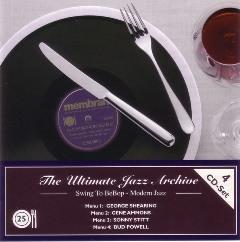The Ultimate Jazz Archive Vol.97 – George Shearing [1947-1953] [2005]
The Ultimate Jazz Archive Vol.97 – George Shearing [1947-1953] [2005]

01.When Darkness Falls 02.So Rare 03.Buccaneer’s Bounce 04.Have You Met Miss Jones 05.Sweet And Lovely 06.Bop’s Your Uncle 07.Sophisticated Lady 08.Cozy’s Bop 09.September In The Rain 10.East Of The Sun (West Of The Moon) 11.Conception 12.Pick Yourself Up 13.Jumpin’ With Symphony Sid 14.I’ll Remember April 15.Summertime 16.I Didn’t Know What Time It Was 17.I’ll Be Around 18.Easy Living 19.How High The Moon 20.Lonely Momets 21.Lullaby Of Birdland 22.Love Is Just Around The Corner
For a long stretch of time in the 1950s and early '60s, George Shearing had one of the most popular jazz combos on the planet -- so much so that, in the usual jazz tradition of distrusting popular success, he tended to be underappreciated. Shearing's main claim to fame was the invention of a unique quintet sound, derived from a combination of piano, vibraphone, electric guitar, bass, and drums. Within this context, Shearing would play in a style he called "locked hands," which he picked up and refined from Milt Buckner's early-'40s work with the Lionel Hampton band, as well as Glenn Miller's sax section and the King Cole Trio. Stating the melody on the piano with closely knit, harmonized block chords, with the vibes and guitar tripling the melody in unison, Shearing sold tons of records for MGM and Capitol in his heyday.
The wild success of this urbane sound obscures Shearing's other great contribution during this time, for he was also a pioneer of exciting, small-combo Afro-Cuban jazz in the '50s. Indeed, Cal Tjader first caught the Latin jazz bug while playing with Shearing, and the English bandleader also employed such esteemed congueros as Mongo Santamaria, Willie Bobo, and Armando Peraza. As a composer, Shearing was best known for the imperishable, uniquely constructed bop standard "Lullaby of Birdland," as well as "Conception" and "Consternation." His solo style, though all his own, reflected the influences of the great boogie-woogie pianists and classical players, as well as those of Fats Waller, Earl Hines, Teddy Wilson, Erroll Garner, Art Tatum, and Bud Powell -- and fellow pianists long admired his light, refined touch. He was also known to play accordion and sing in a modest voice on occasion.
Shearing, who was born blind, began playing the piano at the age of three, receiving some music training at the Linden Lodge School for the Blind in London as a teenager but picking up the jazz influence from Teddy Wilson and Fats Waller 78s. In the late '30s, he started playing professionally with the Ambrose dance band and made his first recordings in 1937 under the aegis of fellow Brit Leonard Feather. He became a star in Britain, performing for the BBC, playing a key role in the self-exiled Stéphane Grappelli's London-based groups of the early '40s, and winning seven consecutive Melody Maker polls before emigrating in New York City in 1947 at the prompting of Feather. Once there, Shearing quickly absorbed bebop into his bloodstream, replacing Garner in the Oscar Pettiford Trio and leading a quartet in tandem with Buddy DeFranco. In 1949, he formed the first and most famous of his quintets, which included Marjorie Hyams on vibes (thus striking an important blow for emerging female jazz instrumentalists), Chuck Wayne on guitar, John Levy on bass, and Denzil Best on drums. Recording briefly first for Discovery, then Savoy, Shearing settled into lucrative associations with MGM (1950-1955) and Capitol (1955-1969), the latter for which he made albums with Nancy Wilson, Peggy Lee, and Nat King Cole. He also made a lone album for Jazzland with the Montgomery Brothers (including Wes Montgomery) in 1961, and began playing concert dates with symphony orchestras.
After leaving Capitol, Shearing began to phase out his by-then-predictable quintet, finally breaking it up in 1978. He started his own label, Sheba, which lasted for a few years into the early '70s -- and made some trio recordings for MPS later in the decade. In the '70s, his profile had been lowered considerably, but upon signing with Concord in 1979, Shearing found himself enjoying a renaissance in all kinds of situations. He made a number of acclaimed albums with Mel Tormé, raising the singer's profile in the process, and recorded with the likes of Ernestine Anderson, Jim Hall, Marian McPartland, Hank Jones, and classical French horn player Barry Tuckwell. He also recorded a number of solo piano albums where his full palette of influences came into play. He signed with Telarc in 1992 and from that point through the early 2000s continued to perform and record, most often appearing in a duo or trio setting. Shearing, who had remained largely inactive since 2004 after a fall in his New York City apartment, died of congestive heart failure at New York's Lenox Hill Hospital on February 14, 2011. He was 91. ---Richard S. Ginell, Rovi
download:
uploaded yandex 4shared mediafire mega solidfiles zalivalka cloudmailru filecloudio anonfiles oboom
Last Updated (Wednesday, 24 September 2014 12:19)








